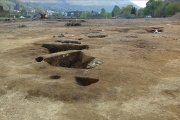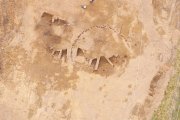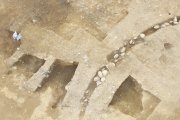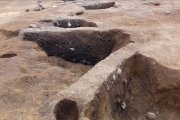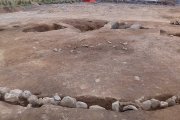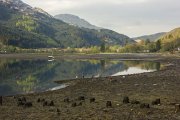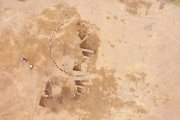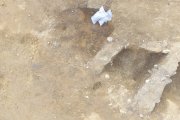Succoth Excavation
Argyll Archaeology was contracted to carry out an archaeological excavation at Succoth, at the head of Loch Long, in 2017, ahead of the recent housing development. The results revealed exciting insights into some of the area's very early inhabitants! Carry on reading for a summary of the results :) Thanks to Argyll Archaeology for letting us print this summary.
Prior to carrying out major new developments, builders are required to make sure that the construction process won’t damage any important archaeological features, and to record any archaeology that will be lost as a result of the proposed work. With this in mind, TSL Contractors contracted Clare Ellis of Argyll Archaeology to excavate the site at Succoth prior to the building of the new houses. This provided an excellent opportunity to investigate this potentially interesting area near the head of Loch Long, which would otherwise have remained unexplored.
Sadly, the dig wasn’t open to community involvement because of health and safety issues and tight time constraints. However, following an initial archaeological evaluation in November 2014, the topsoil was removed and an excavation of part of the site was carried out in April/May 2017. Despite a lack of any obvious archaeological structures, the patterns made by the different soil colours suggested that this little piece of land had a fascinating history!
If holes get made in the surface of the soil - either by natural causes like erosion, uprooted trees, or animal burrows, or by man’s activity – those holes fill up again over time. However, the stuff they fill up with is different from the soil around them, and might also contain things that fell or got put into the hole before it got filled, like pieces of charcoal from fires, or other signs of human activity. If some of these things can be dated, it can provide clues about when people were living in the area and what they were doing.
The earliest signs of archaeology consisted of holes made by the roots of trees when they fell over (‘tree-throws’), which had filled up with silt containing lots of charcoal. The approximate date when the wood was burnt to produce charcoal can be calculated using a technique called ‘carbon dating’, while examination of the charcoal under a microscope can identify what sort of tree it came from. There were two main sorts of charcoal – one from willow burnt over a 200-400-year period around 5800 years BC (referred to as the Late Mesolithic period), and another from hazel burnt much later, around 3500 BC (Late Mesolithic/Early Neolithic). There were also signs of oak, alder, and birch. Mesolithic cultures are usually associated with a nomadic, hunter-gatherer lifestyle, while the Neolithic period saw people becoming more settled and starting to farm the land. Although the charcoal, together with a few burnt hazelnut shells, could have been the remains of cooking fires, the wide spread of charcoal across the area could indicate deliberate burning of the woodland, or may have been the product of natural fires.
In addition to the charcoal, numerous pieces of quartz and a few pieces of flint that showed signs of having been shaped into tools were recovered from the hollows. Based on their shapes, these ‘lithics’ have been dated to between 6000 to 5600 BC, i.e., the Late Mesolithic, similar to the first lot of charcoal. Interestingly, although some of the lithics were burnt suggesting that they had been on the ground when the burning happened, most showed no signs of burning, indicating that the site saw more than one visit by hunter/gatherers over a relatively short period of time.
Around the Late Mesolithic/Early Neolithic period, at the same time as the later burning, people had cut a number of ditches including holes that would have held wooden posts. It was possible to date these ditches based on the quartz and worked flint recovered from them. Although these curvilinear ditches and their postholes had clearly been deliberately constructed, their functions were elusive; maybe the posts formed a sort of windbreak or a screen for whatever activity was taking place within the ditches?
The most recent feature excavated at Succoth was a circular enclosure about 11m in diameter. The ditch marking the edge of the enclosure included many rounded cobbles, some of which may have served as packing to support small posts. However, the remains of the enclosure had been damaged by later ploughing and cultivation. Although there was nothing in the ditches that could be used to date this enclosure, its position relative to the earlier pits and ditches indicated that it was made later than these, and it may have been constructed in the later prehistoric or early medieval period.
To put the findings at Succoth in context, an abrupt cooling of the climate occurred around 6200 BC when the temperature cooled by 2-3°C, associated with a reduction in tree cover. This might have had a severe impact on Mesolithic people, and some have suggested that the population in western Scotland declined until around 5550 BC (just after the period of 200-400 years of potential activity at Succoth). Importantly however, recent discoveries at Carsaig and Lochgoilhead, as well as the current excavation at Succoth, suggest that this population decline may not have been as dramatic as previously thought. Another factor to consider is that sea levels have changed dramatically over time, probably reaching a maximum around 3700-3500 BC (Early Neolithic), after the end of the last Ice Age and the melting of the ice.
In conclusion, the excavation revealed that people were using the area at the head of Loch Long for a period of about 200-400 years during the Late Mesolithic, around 5800 BC. They were making tools, predominantly of quartz, with flint tools being rarer, probably reflecting the lack of flint beach pebbles on Loch Long compared with more exposed beaches. The woodland at this time was dominated by oak and hazel, with more wet-tolerant species such as willow and alder growing nearer the shore. No hearths were discovered, and the extent of the charcoal-rich deposits may indicate that the woodland had been burnt on more than one occasion, either deliberately or as a consequence of natural processes. The use of the site coincided with a deterioration in the weather, which became colder and wetter, while a likely increase in storms may have uprooted trees, creating the hollows that subsequently accumulated the charcoal and lithics.
The early burning events evidenced by the willow charcoal ceased around 5600 BC, with no further signs of use of the site for the next 1800 years or so, when two ditches with post holes were dug. The purpose of these later features is unknown, although the postholes may have supported some form of screening. The posts rotted in situ, and the site may have been abandoned as a result of rising sea levels. A considerable time later, perhaps in the Bronze Age or even during the medieval period, a circular wood and wattle enclosure was then built over the earlier ditches, possibly as a stock enclosure.
Signs of ploughing and cultivation suggest that this part of what is now Succoth continued to be used, at least intermittently, until the present day, with the new houses being just the latest chapter in its long story.
Blog
Click on the link here to check out our Facebook page.
Events
Click here to find out about forthcoming events and how to get involved.
Timeline
Click here to see our timeline of events.
Location
Click here to find out where the Hidden Heritage Project is taking place.
Contact Us
Click here for our contact details.



